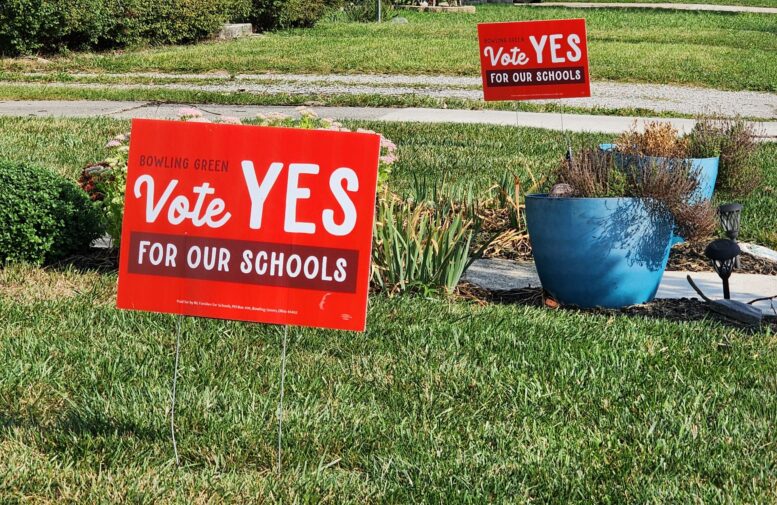By JAN McLAUGHLIN
BG Independent News
The unofficial results of Tuesday’s election show Bowling Green City School District’s income tax levy losing by 150 votes (6,875 to 7,025.)
That means the district is going to face some tough decisions.
“We have to balance our budget – by increasing our revenue through a levy or making major cuts to programs and personnel,” Superintendent Ted Haselman said late Tuesday night.
“I thought we were very transparent that this is a need – not a want,” he said.
Haselman said he will recommend the school board put the 0.75% income tax back on the ballot next spring. That will be the last chance to prevent cuts, he said.
“We have to have some tough conversations,” Board President Tracy Hovest said, predicting the levy request in the spring will be the same. “Our needs stay the same.”
Haselman holds out hope that when the provisional ballots are added in, the school levy may end up passing. The Wood County Board of Elections reported to him that more than 1,900 provisional ballots were cast countywide, with hundreds of them from residents living in the school district.
“So we really don’t know what the outcome is,” he said.
Jeff Dennis, a member of the BG Families for Schools organization, which worked to support the levy, is also hopeful the election result will change once all the votes are counted.
“It’s looking like a tough night for school districts throughout Wood County,” Dennis said. “Fortunately, BGCS is unique in that we’re only down 150 votes with several thousand provisional ballots left to count. I think you’ll find the majority of those ballots are from areas where we are seeing 70% plus support. It’s razor thin at this point, and we’re looking forward to counting every vote.”
According to the board of elections’ website, valid provisional ballots will be included in the official count to be held no later than 21 days after the election.
Bowling Green City School District had asked voters to support a 0.75% continuing income tax for daily operations. It was the first new operating levy for the district since 2010.
“That’s been 14 years, which is a long time for a school district to not have new operating dollars passed by its community,” Haselman said.
Voters were cautioned that when communities don’t pay to operate their schools, teachers lose their jobs and students pay the price, with consequences such as teacher layoffs, fewer course offerings, cuts to after-school activities, and bigger class sizes.
Prior to trying the levy in the spring, the board will have to decide what goes on the chopping block if it fails again.
“I anticipate the board will discuss what will be cut if we don’t pass it in the spring,” Hovest said.
Haselman said the district will make it clear exactly what is at stake. The cuts will inevitably include staff.
“We’re in the education business. So 80% of our budget is people,” he said, adding that voters will be given specifics on what people and programs will be cut. “So people can decide what they want their school district to look like.”
As he worked to educate voters prior to Tuesday, Haselman used numbers to explain why the levy was necessary. Since the last new operating levy was passed in 2010, school revenue has gone up an average of 1.75% annually. School expenditures have gone up 2.42% annually. And inflation has outpaced them both, pushing up 3.18% annually.
District officials also used a chart comparing local tax collections for 15 area school districts. Bowling Green is ranked fourth from the bottom, and has one of the lowest income taxes in the area at 0.5% currently.
Haselman pointed to the district’s most recent state report card as proof that Bowling Green is providing a top-notch education for students. BG improved its overall score, ranking it above every district in the county except Perrysburg.
School officials heard questions of why the district needs more money after it just passed a bond issue last fall to build a new high school. Haselman pointed out that bond money can’t be used for daily operations, which include expenses like personnel costs, classroom supplies, facilities maintenance, textbooks, technology, transportation and utilities.
“This is how school funding works in Ohio,” he said.





